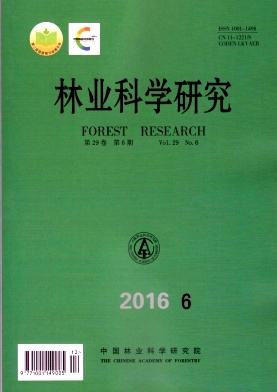|
[1]
|
邹军, 张明礼, 杨浩. 退耕还林(草)与水土保持若干问题的研究进展[J]. 土壤通报, 2012, 43(2): 506-512.
|
|
[2]
|
胡婵娟, 郭雷. 植被恢复的生态效应研究进展[J]. 生态环境学报, 2012, 21(9): 1640-1646.
|
|
[3]
|
Zhang B, Yang Y, Zepp H. Effect of vegetation restoration on soil and water erosion and nutrient losses of a severely eroded clayey Plinthudult in southeastern China[J]. Catena, 2004, 57: 77-90. |
|
[4]
|
Zhang F L. Effect of vegetation changes on soil erosion on the Loess Plateau[J]. Pedosphere, 2006, 16: 420-427. |
|
[5]
|
刘满强, 胡锋, 何园球, 等. 退化红壤不同植被恢复模式下土壤微生物量季节动态及其指示意义[J]. 土壤学报, 2003, 40(6): 937-943.
|
|
[6]
|
Bossio D A, Scow K M. Impact of carbon and flooding on the metabolic diversity of microbial communities in soils[J]. Applied and Environmental Microbiology, 1995, 61(11): 4043-4050. |
|
[7]
|
Rogers B F, Tate R L. Temporal analysis of the soil microbial community along a topo sequence in pineland soils [J]. Soil Biology & Biochemistry, 2001, 33(10): 1389-1401. |
|
[8]
|
胡海波, 张金池, 高智慧. 岩质海岸防护林土壤微生物数量及其与酶活性和化学性质的关系[J]. 林业科学研究, 2001, 15(1): 88-95.
|
|
[9]
|
Aciego Pietri J C, Brookes P C. Substrate inputs and pH as factors controlling microbial biomass, activity and community structure in an arable soil[J]. Soil Biology & Biochemistry, 2009, 41(7): 1396-1405. |
|
[10]
|
Nobili M D, Contin M, Mondini C,et al. Soil microbial biomass is triggered into activity by trace amounts of substrate[J]. Soil Biology & Biochemistry, 2001, 33(9), 1163-1170. |
|
[11]
|
于树, 汪景宽术, 高艳梅, 等. 地膜覆盖及不同施肥处理对土壤微生物量碳和氮的影响[J]. 沈阳农业大学学报, 2006, 37(4): 602-606.
|
|
[12]
|
单鸿宾, 梁智, 王纯利, 等. 连作及灌溉方式对棉田土壤微生物量碳氮的影响[J]. 干旱地区农业研究, 2010, 28(4): 202-205.
|
|
[13]
|
Moore J M, Klose S, Tabatabai M A. Soil microbial biomass carbon and nitrogen as affected by cropping systems[J]. Biol Fertil Soils, 2000, 31: 200-210. |
|
[14]
|
Kandeler E, Tscherko D, Spiegel H. Long-term monitoring of microbial biomass, N mineralisation and enzyme activities of a Chernozem under different tillage management[J]. Biology and Fertility of Soils, 1999, 28(4): 343-351. |
|
[15]
|
闫浩, 赵彤, 蒋跃利, 等. 黄土丘陵区植被类型对土壤微生物量碳氮磷的影响[J]. 生态学报, 2013, 33(18): 1-8.
|
|
[16]
|
蔡志坚, 蒋瞻, 杨加猛, 等. 环境治理视角下石漠化片区的农业发展[J]. 江淮论坛, 2014(2): 18-28.
|
|
[17]
|
韩克松. 退耕还林对农户可持续生计的影响探讨[J]. 绿色科技, 2014(2): 131-132.
|
|
[18]
|
中国科学院南京土壤研究所微生物室. 土壤微生物研究法[M]. 北京: 科学出版社, 1985.
|
|
[19]
|
李振高, 骆永明, 滕应. 土壤与环境微生物研究法[M]. 北京: 科学出版社, 2008.
|
|
[20]
|
全国农业技术推广服务中心. 土壤分析技术规范(第二版)[M]. 北京: 中国农业出版社, 2006.
|
|
[21]
|
李亮. 乌兰布和沙漠东北部沙区农田和林地土壤微生物及酶活性研究. 杨陵:西北农林科技大学, 2010.
|
|
[22]
|
薛立, 赖日石, 陈红跃, 等. 深圳宝安区生态风景林典型造林地土壤养分、微生物和酶活性的研究[J]. 林业科学研究, 2002, 15(2): 242-246.
|
|
[23]
|
张笑培, 杨改河, 王得祥, 等. 黄土高原沟壑区不同植被恢复模式对土壤生物学特性的影响[J]. 西北农林科技大学学报:自然科学版, 2008, 36(5): 149-159.
|
|
[24]
|
薛楚, 刘国彬, 藏全厚, 等. 侵蚀环境生态恢复过程中人工刺槐林(Robinia pseudoacacia)土壤微生物量演变特征[J]. 生态学报, 2007, 27(3): 909-917.
|
|
[25]
|
刘栋, 黄懿梅, 安韶山. 黄土丘陵区人工刺槐林恢复过程中土壤氮素与微生物活性的变化[J]. 中国生态农业学报, 2012, 20(3): 322-329.
|
|
[26]
|
Wardle D A. Controls of temporal variability of the soil microbial biomass: a global-scale synthesis[J]. Soil Biology & Biochemistry, 1998, 30(13): 1627-1637. |
|
[27]
|
Cleveland C C, Liptzin D. C: N: P stoichiometry in soil: is there a Redfield ratio" for the microbial biomass[J]. Biogeochemistry, 2007, 85(3): 235-252. |
|
[28]
|
赵彤, 闫浩, 蒋跃利, 等. 黄土丘陵区植被类型对土壤微生物量碳氮磷的影响[J]. 生态学报, 2013, 33(18): 5615-5622.
|
|
[29]
|
李娟, 赵秉强, 李秀英, 等. 长期有机无机肥料配施对土壤微生物学特性及土壤肥力的影响[J]. 中国农业科学, 2008, 41(1): 144-152.
|
|
[30]
|
Parffit R L, Yeates G W, Ross D J, et al. Relationships between soil biota, nitrogen and phosphorus availability, and pasture growth under organic and conventional management[J]. Applied soil ecology, 2005, 28(1): 1-13. |
|
[31]
|
孙儒泳, 李博, 诸葛阳, 等. 普通生态学[M]. 北京: 高等教育出版社, 1993: 132-135.
|
|
[32]
|
邵泽坦. 刺槐栓皮栎混交林调查报告[J]. 山东林业科技, 1992, 84(3): 33-35.
|





 DownLoad:
DownLoad: